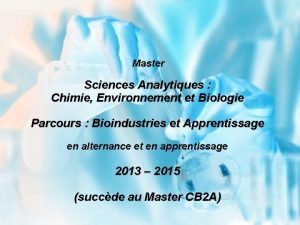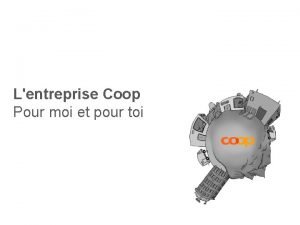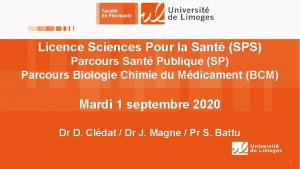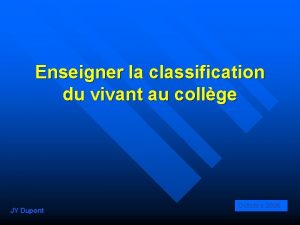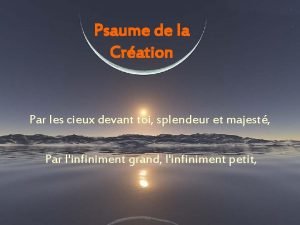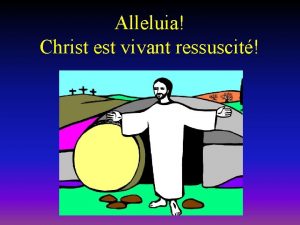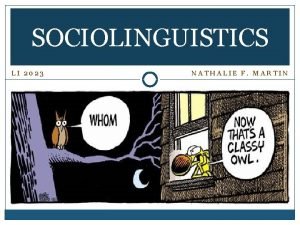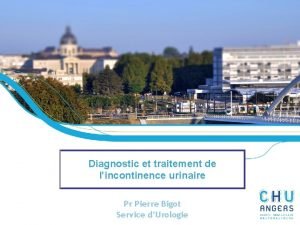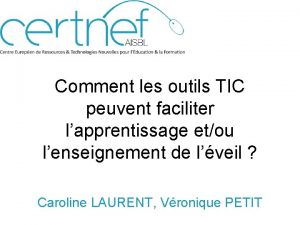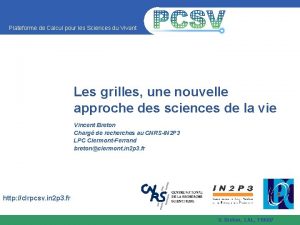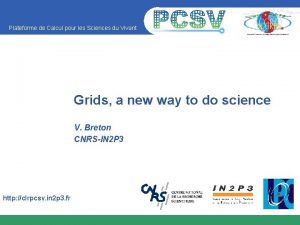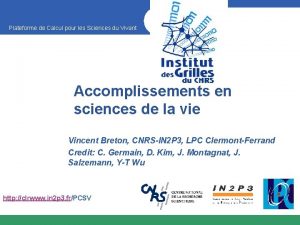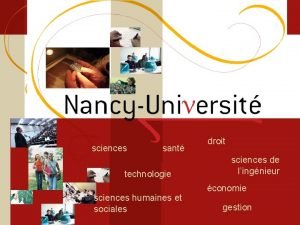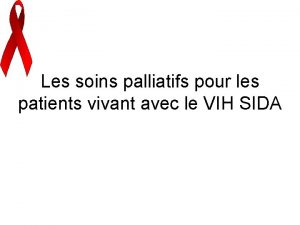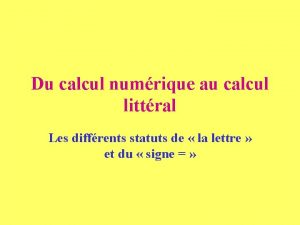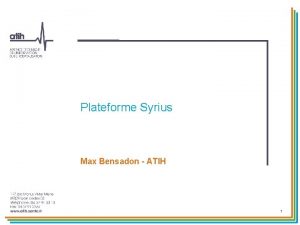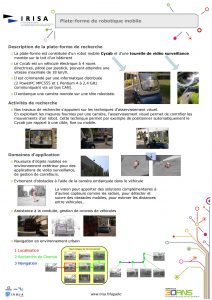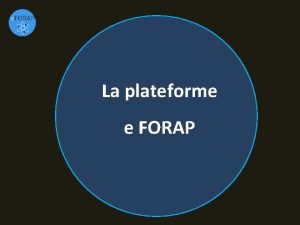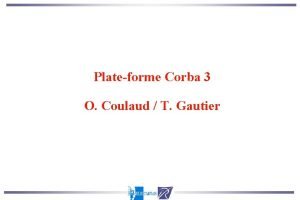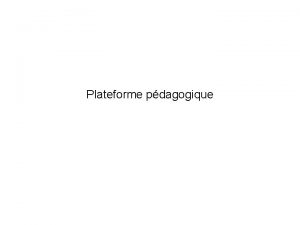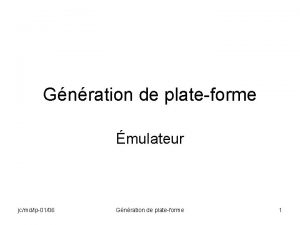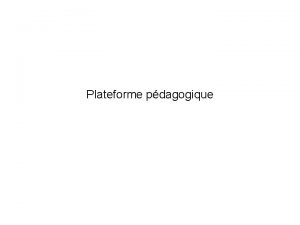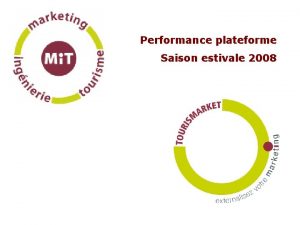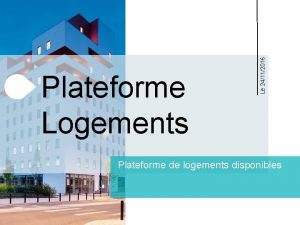Plateforme de Calcul pour les Sciences du Vivant






















- Slides: 22

Plateforme de Calcul pour les Sciences du Vivant Interdisciplinary activities V. Breton CNRS-IN 2 P 3, LPC Clermont-Ferrand RECFA open day, May 12 2006 Credits: A. Billebaud, M. Farizon, J-M Fontbonne, S. Incerti, P. Le Dû, S. Leray, E. Suraud http: //clrpcsv. in 2 p 3. fr

Introduction • Our core activity is to understand the universe at small and at cosmological distances • Competences acquired to support core projects can benefit other scientific domains – Accelerators – Detectors – Computing • We are called upon to contribute our scientific competence to other fields of science and to solve certain problems raised by the society • Development of interdisciplinary research on two main fronts – Interface with life sciences (on the steps of Marie Curie) – Processing of nuclear wastes

Interdisciplinary research at IN 2 P 3 Chemistry Life sciences - Radiochemistry - Detection of trace elements - Waste treatment - Medical imaging - Hadron therapeutic cancer treatment - DNA Sequencing - Study of Low doses Environment - Waste treatment - Oceanography - Low level radioactivity Sciences of the universe - Astrophysics and cosmology - Oceanography - Waste treatment - Low-level radioactivity - Dating Social sciences IN 2 P 3 MIPPU (mathematics, computer science, physics and universe) - Theoretical physics - Materials for detectors - Solid state physics - Behavior of irradiated materials - Aggregates - Telecommunications - Grids - Dating - Risk Perception - History of sciences Engineering - Microelectronics - Highly stable lasers - Waste treatment

Physics and chemistry for nuclear energy and environment • Nuclear energy is probably going to regain momentum in the close future – – Awareness of the impact of fossil energy on greenhouse effect Growing need of emerging countries Limited reserves and foreseeable exhaustion of fossil energy Limited capacity of renewable energies • In this perspective, convincing answers must be found to issues related to – Waste management – Security – Non-proliferation • New types of reactors, new methods for characterizing nuclear material are under study

Research activities at IN 2 P 3 and DAPNIA • Radiochemistry: Physics and Chemistry of radioactive materials produced in the present and future nuclear energy sector, in the environment (waste storage sites) and in medecine – Resources: 5 IN 2 P 3 laboratories, 45 permanent staff + 30 non permanent staff • Metrology: measurement and monitoring of radioactivity in the environment – Resources: 20 staff + 8 NP staff • Study of physics and scenarios for future reactors – Resources: 15 staff + 8 NP staff • Nuclear physics for future reactors and other applications – Resources: 27 staff + 16 NP staff

Organization of work and perspectives • Organization of work – CNRS interdisciplinary program PACE (Nuclear Cycle Post Processing program) – CNRS Research Groups : PRACTIS, NOMADE, GEDEPEON – European FP 6 projects: ACTINET 6, IP-EUROTRANS, … – Collaboration with CEA and industry (EDF, ANDRA, FRAMATOME, COGEMA) • Scientific prospects for the next 10 years: carry out upstream research in the electro-nuclear field – Acquisition of fundamental data (spallation, captures, fission) – Study hybrid systems for transmutation – Contribute to the study of innovating systems for the future nuclear energy

Interaction of particles with matter • Interdisciplinary research on accelerators and ion beams • Main research areas – Collision processes – Understanding energy deposit by polyatomic projectiles such as aggregates or molecules in solids – Simulation of particle interaction with materials – Experimental simulation of material aging under irradiation – Use of structural changes induced by ion and aggregate beams • Resources: > 4 laboratories, ~ 34 staff in IN 2 P 3 laboratories (20% of the french research community)

Organization of work and perspectives • Organization of work – Natural collaboration with the scientific communities using accelerators and ion beams – Lack of organization around the different levels of interaction between particle and matter § Community of 170 researchers spread in 24 laboratories • Perspectives – Creation of a Research Group (GDR) “fundamental research on particle – matter interaction” – Identified common topics of interest § Elementary collision processes § Fragmentation paths, energy and excitation transfer mechanisms in molecules and aggregates § Relaxation paths for materials under irradiation § Modeling of matter energy transfer and relaxation phases § Impact of different levels of disorder on biological, physical and chemical properties of materials

Life sciences • Main research areas – Physical and chemical characterization of living organisms Radiobiology Radiotherapy Medical and biological imaging Informatics for life sciences • • • – – Resources – 10 laboratories (including CEA) – 70 staff members (50 researchers, 20 technical staff) A significant scientific production – 29 thesis, 65 papers, 14 patents Partners – Hospitals, universities, CEA (life science department), CNRS (life science, engineering departments), INSERM (national institute for medical research), FP 6 European projects

Physical and chemical characterization of living organisms • Tools: accelerators of light / polyatomic ions • Techniques used: imaging, chemical analysis, local irradiation • Resources: 4 laboratories, 13 staff + 11 NP staff • 3 research areas – Characterization of interfaces between biomaterials and living tissues – Characterization of biomolecules for bacteriology and environment – Chemical exploration of cells to study exposure to nanoparticles and metals

Radiobiology • Radiobiology is about characterizing and quantifying irradiation effects on biological systems • Tools: 4 accelerator facilities (neutron, proton and ion beams) • Resources: 4 laboratories, ~ 8 staff and 5 NP staff • Research areas – Intermolecular dynamics under irradiation – Search for molecules or nano-objects increasing or inhibiting radio sensitivity – DNA lesions and genomic instabilities induced by irradiation – Irradiation of Intracellular targets – intra and extra cellular messaging after irradiation Direct and indirect impact of radiations on DNA

Radiotherapy • Radiotherapy is about using ionizing particles to kill cancerous cells • Resources: 4 laboratories, 8 staff and 10 NP staff • Research areas – Treatment planning – Development of accelerators for radiotherapy treatment – Quality control (beam dosimetry, on-line monitoring) Simulation of an electron accelerator using GATE

Medical and biological imaging • Development of imaging systems based on technological expertise • Resources: 10 laboratories, 35 staff + 20 NP staff • Research areas cover imaging devices from molecule to man – In vitro imaging – In vivo imaging (PET, SPECT, MRI) – Multi-modal imaging – Per-operative imaging • Highlight: creation of a laboratory dedicated to brain functional imaging – Location: Orsay – Joint IN 2 P 3 -CNRS Life Science Department laboratory Per-operative compact imager, IPN Orsay

Activities in medical imaging at IN 2 P 3 and DAPNIA � � � TOHR x. Tal � LXe SIC AIF � POCI � � � � �

Informatics for life sciences • Resources: – 7 laboratories – 6 staff + 20 NP staff • Research areas Nuclear Medecine Radiobiology Radiotherapy GEANT 4 GATE – Simulation for dosimetry and imaging (GATE) Simulation – Simulation for Modeling radiobiology (Geant 4) – Grids for life sciences and healthcare Life sciences Healthcare Grids Data handling and analysis Medical and Biological imaging Innovating technologies Detectors Fundamental research in nuclear and particle physics

Grid-enabled in silico drug discovery • Goal: reduce time and cost to develop new drugs by selecting the best drug candidates – Particularly relevant to neglected and emerging diseases • Strategy: deploy virtual screening on grids – Screening = selection of molecules active on a given protein target – Grid added value: access to huge computing resources Countries contributing to EGEE Biomedical Virtual Organization • Successful deployment on EGEE against malaria and bird flu – Malaria: 46 millions docking probabilities computed in 6 weeks in the summer 2005 – Bird flu: 100 CPU years to find new drugs against mutated neuraminidase N 1 • Role of IN 2 P 3: coordination of the grid deployments Number of malaria related jobs waiting and running on EGEE vs time

Organization of work at the interface with life sciences • Interface with life sciences has been loosely structured in the last millennium – Local collaboration with hospitals or university groups – Transfer of expertise for technical developments • Life sciences are moving into “big science” – Molecular biology experimental platforms produce very large volumes of data studied by international collaborations – Research equipments become national (Neuro. Spin, Hadrontherapy centre) – Europe has developed large scale projects (No. E, IP) in FP 6 • Interface with life sciences is being structured – Appointment of “chargés de mission” at CEA-DAPNIA (P. Le Dû, P. Mangeot) and a scientific deputy director in charge of interdisciplinary activities at IN 2 P 3 (E. Suraud) – Research Group (GDR) “Instrumentation and simulation for biomedical imaging” started in 2005 – Involvement in european projects (CELLION, MAESTRO, EGEE, Embrace, Bioinfo. GRID) – Bilateral collaborations with Germany, Austria, Korea, Taïwan, …

Scientific prospects for the next 10 years • Objective 1: contribute to the next generation of FEL and to the R&D on the cold technology of the e+elinear collider (TESLA) • Objective 2: Contribute to the design and building of proton- and hadron-therapy centres • Objective 3: Develop innovating imaging techniques in biology and medecine • Objective 4: Contribute to emergence in France of multidisciplinary platforms based on ion beams for the irradiation and the modification of materials coupled with electron microscopes techniques or imaging systems From Quarks to cosmos, scientific prospects of the next 10 years for nuclear and high energy physics of the IN 2 P 3 -CNRS and the DAPNIA-DSM-CEA, November 2005

Highlight within objective 2 : the ETOILE project • Goal: build a national centre for lightion hadrontherapy in France • Location: Lyon, Rhone-Alpes region • Budget: – 90 M€ to build the centre – A routine flux of 1000 patients per year will be reached after 3 years with an operation cost of 15 M Euro. • Status: approved by the french government in May 2005 • Research areas involving IN 2 P 3 laboratories: – design of an in-beam PET detector – simulation of the interaction of carbon ions with tissues – radiobiological studies on the radiosensitivity and tolerance of normal tissues and on the radioresistance of tumours Online PET at GSI hadrontherapy facility

Highlight within objective 4: the AIFIRA platform Nanobeam High resolution analysis Tomography Localized irradiation Local induction of charges AIFIRA Location: Bordeaux Budget: 2, 8 M€ Energy stability E/E ~ 2. 5 10 -5 Spatial resolution up to 100 nm Microbeam Extracted beam Radiobiology Charpa Characterization and analysis Automatized line Atmospheric dusts Physics line Production of neutrons Extracted beam Air analysis Archeological samples j

Funding • Funding is almost strictly going to projects – Staff recruited for project duration • Regions are very supportive of infrastructures – Accelerators (AIFIRA, Etoile) – Grid infrastructures (Auvergrid) • Newly created National Research Agency (ANR) supports multidisciplinary research projects – Several projects led by IN 2 P 3 laboratories already supported – ANR will play a growing role as a funding agency for interdisciplinary activities • European projects – IN 2 P 3 involved in several European projects – Important resource for grid related activities

Conclusion • Interdisciplinary activities involve a significant fraction of IN 2 P 3 staff – Growing involvement of researchers and engineers – Growing budget (National Research Agency, European projects) • Main interfaces – Physics and chemistry for nuclear energy and environment – Life sciences – But also interaction of particles with matter, … • Perspectives – IN 2 P 3 and CEA are ready to carry out upstream research in the electronuclear field § Nuclear energy is now part of nuclear physics program at IN 2 P 3 – Structuring of interface with life sciences is underway § Etoile hadron therapy centre in Lyon and AIFIRA multidisciplinary platform in Bordeaux will be important centers of gravity for the future § Emergence of bioinformatics in relation to grids
 Master sciences analytiques pour les bioindustries
Master sciences analytiques pour les bioindustries Cestbeaulavie
Cestbeaulavie Un texte expressif
Un texte expressif Formule calcul gicleur fioul
Formule calcul gicleur fioul Coop mazout
Coop mazout Parcours kiné
Parcours kiné Human sciences tok definition
Human sciences tok definition Par les cieux devant toi paroles
Par les cieux devant toi paroles Je me sens vivant
Je me sens vivant Comprendre et enseigner la classification du vivant
Comprendre et enseigner la classification du vivant Dieu vivant dieu tres haut
Dieu vivant dieu tres haut Pitie seigneur
Pitie seigneur Par les cieux devant toi
Par les cieux devant toi Chant mon dieu tu es grand tu es beau paroles
Chant mon dieu tu es grand tu es beau paroles Les voix de dieu
Les voix de dieu Sperimentalismo anticlassico
Sperimentalismo anticlassico Alleluia christ est vivant il est ressuscité
Alleluia christ est vivant il est ressuscité Mon dieu tu es grand
Mon dieu tu es grand Jeune vivant ca
Jeune vivant ca Chiac pour les dummies
Chiac pour les dummies бетмига
бетмига A toutes les mamans du monde
A toutes les mamans du monde Les outils pédagogiques pour faciliter lapprentissage
Les outils pédagogiques pour faciliter lapprentissage
